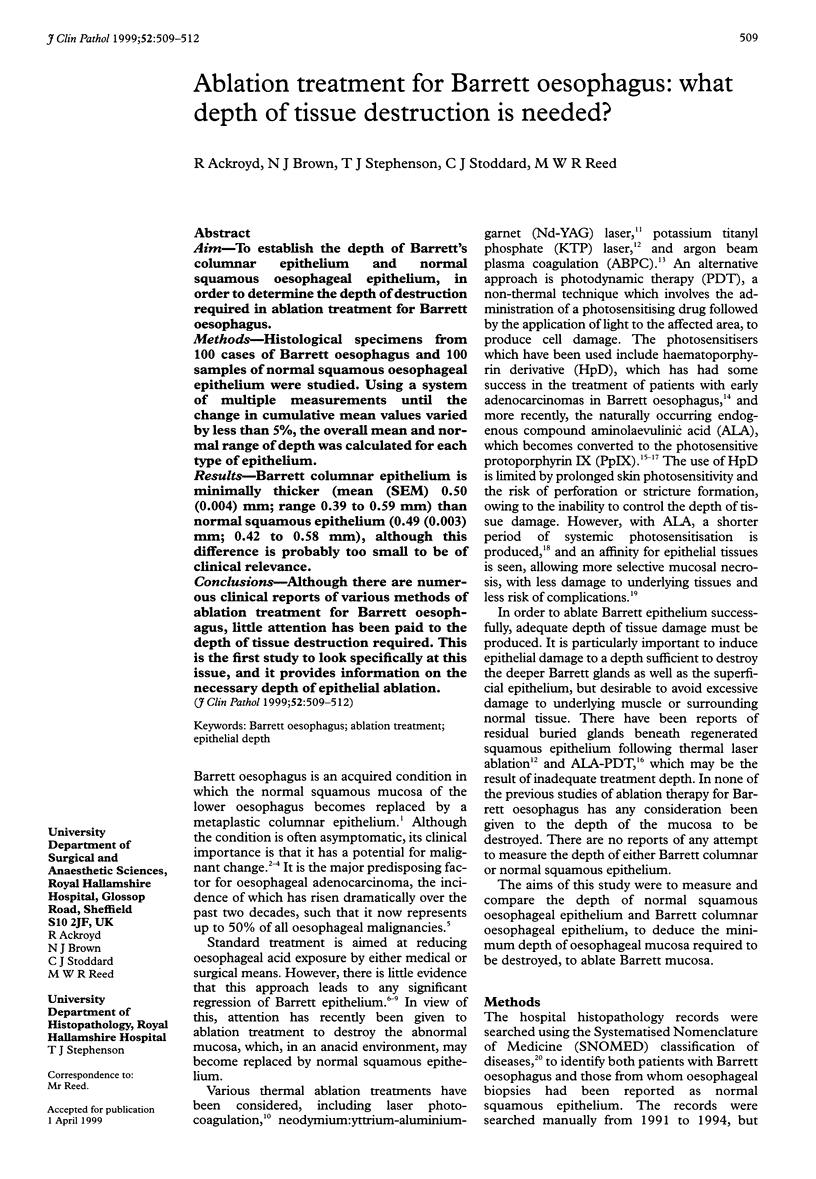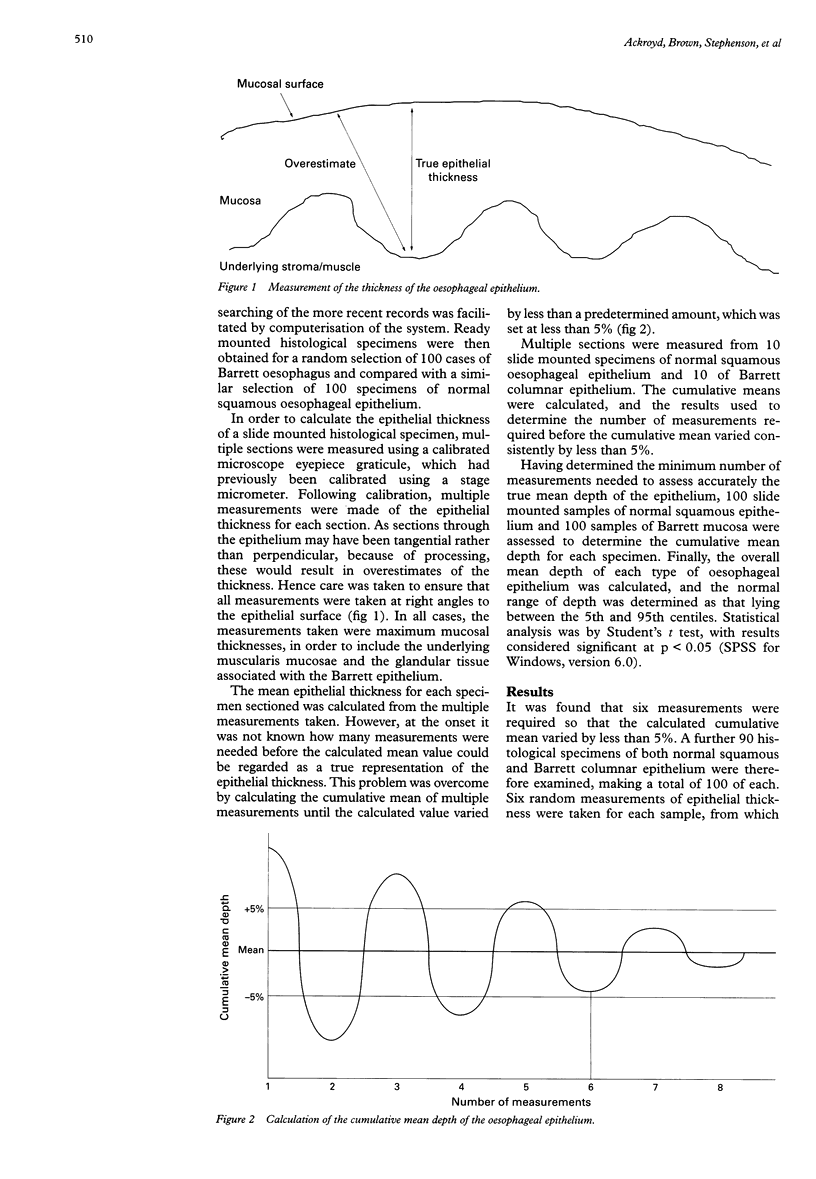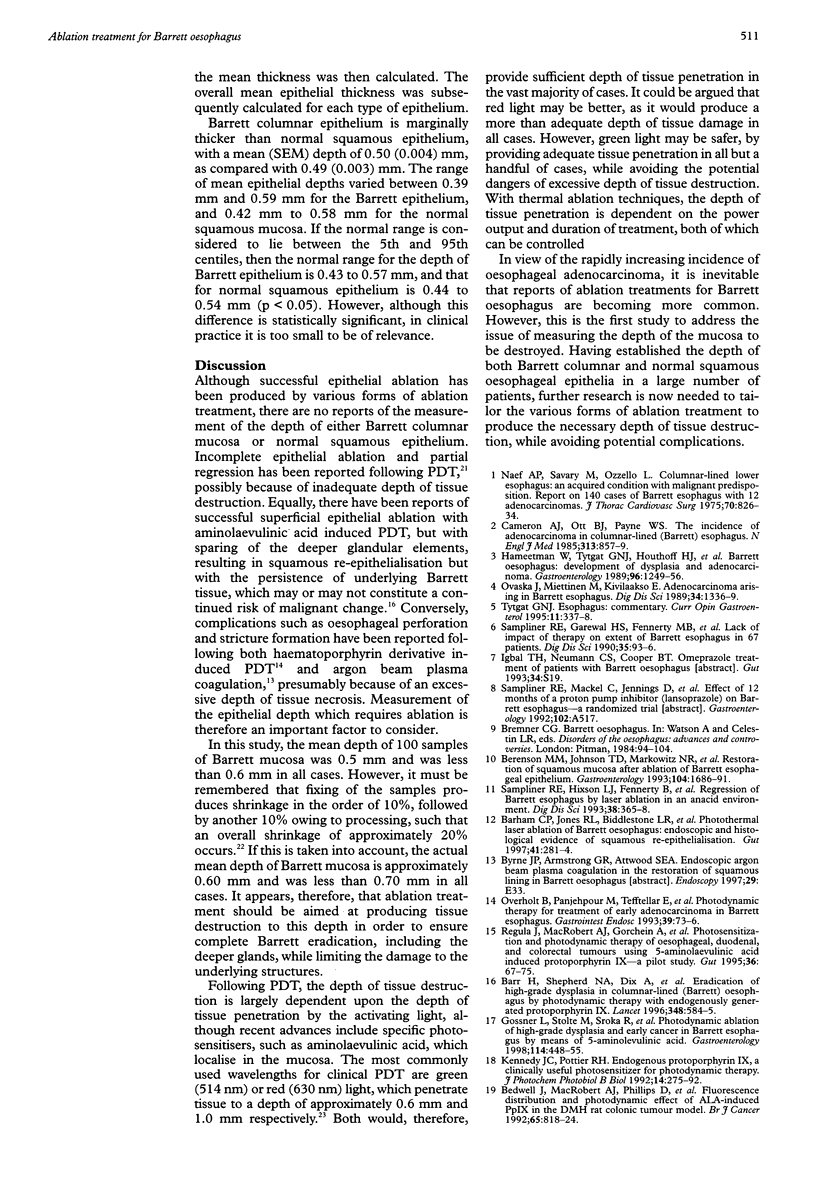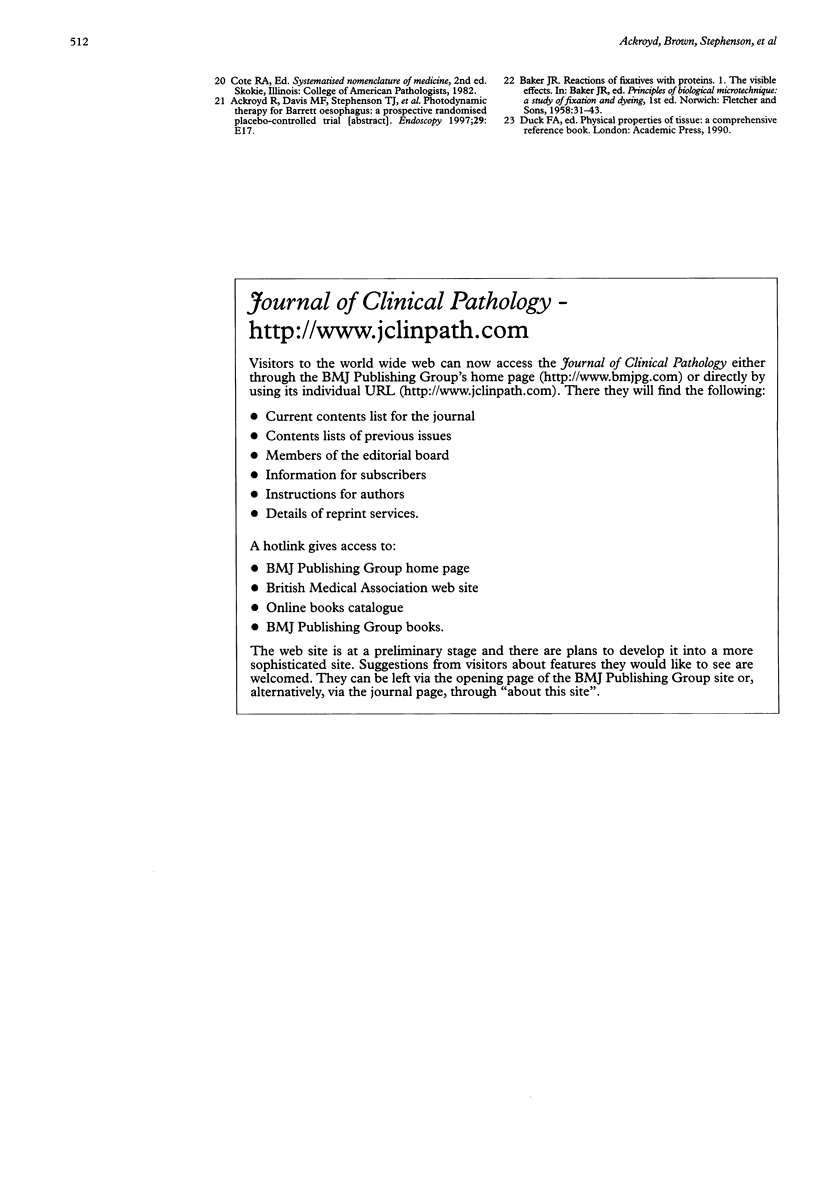Abstract
AIM: To establish the depth of Barrett's columnar epithelium and normal squamous oesophageal epithelium, in order to determine the depth of destruction required in ablation treatment for Barrett oesophagus. METHODS: Histological specimens from 100 cases of Barrett oesophagus and 100 samples of normal squamous oesophageal epithelium were studied. Using a system of multiple measurements until the change in cumulative mean values varied by less than 5%, the overall mean and normal range of depth was calculated for each type of epithelium. RESULTS: Barrett columnar epithelium is minimally thicker (mean (SEM) 0.50 (0.004) mm; range 0.39 to 0.59 mm) than normal squamous epithelium (0.49 (0.003) mm; 0.42 to 0.58 mm), although this difference is probably too small to be of clinical relevance. CONCLUSIONS: Although there are numerous clinical reports of various methods of ablation treatment for Barrett oesophagus, little attention has been paid to the depth of tissue destruction required. This is the first study to look specifically at this issue, and it provides information on the necessary depth of epithelial ablation.
Full text
PDF



Selected References
These references are in PubMed. This may not be the complete list of references from this article.
- Barham C. P., Jones R. L., Biddlestone L. R., Hardwick R. H., Shepherd N. A., Barr H. Photothermal laser ablation of Barrett's oesophagus: endoscopic and histological evidence of squamous re-epithelialisation. Gut. 1997 Sep;41(3):281–284. doi: 10.1136/gut.41.3.281. [DOI] [PMC free article] [PubMed] [Google Scholar]
- Barr H., Shepherd N. A., Dix A., Roberts D. J., Tan W. C., Krasner N. Eradication of high-grade dysplasia in columnar-lined (Barrett's) oesophagus by photodynamic therapy with endogenously generated protoporphyrin IX. Lancet. 1996 Aug 31;348(9027):584–585. doi: 10.1016/s0140-6736(96)03054-1. [DOI] [PubMed] [Google Scholar]
- Bedwell J., MacRobert A. J., Phillips D., Bown S. G. Fluorescence distribution and photodynamic effect of ALA-induced PP IX in the DMH rat colonic tumour model. Br J Cancer. 1992 Jun;65(6):818–824. doi: 10.1038/bjc.1992.175. [DOI] [PMC free article] [PubMed] [Google Scholar]
- Berenson M. M., Johnson T. D., Markowitz N. R., Buchi K. N., Samowitz W. S. Restoration of squamous mucosa after ablation of Barrett's esophageal epithelium. Gastroenterology. 1993 Jun;104(6):1686–1691. doi: 10.1016/0016-5085(93)90646-t. [DOI] [PubMed] [Google Scholar]
- Cameron A. J., Ott B. J., Payne W. S. The incidence of adenocarcinoma in columnar-lined (Barrett's) esophagus. N Engl J Med. 1985 Oct 3;313(14):857–859. doi: 10.1056/NEJM198510033131404. [DOI] [PubMed] [Google Scholar]
- Gossner L., Stolte M., Sroka R., Rick K., May A., Hahn E. G., Ell C. Photodynamic ablation of high-grade dysplasia and early cancer in Barrett's esophagus by means of 5-aminolevulinic acid. Gastroenterology. 1998 Mar;114(3):448–455. doi: 10.1016/s0016-5085(98)70527-x. [DOI] [PubMed] [Google Scholar]
- Hameeteman W., Tytgat G. N., Houthoff H. J., van den Tweel J. G. Barrett's esophagus: development of dysplasia and adenocarcinoma. Gastroenterology. 1989 May;96(5 Pt 1):1249–1256. doi: 10.1016/s0016-5085(89)80011-3. [DOI] [PubMed] [Google Scholar]
- Kennedy J. C., Pottier R. H. Endogenous protoporphyrin IX, a clinically useful photosensitizer for photodynamic therapy. J Photochem Photobiol B. 1992 Jul 30;14(4):275–292. doi: 10.1016/1011-1344(92)85108-7. [DOI] [PubMed] [Google Scholar]
- Naef A. P., Savary M., Ozzello L. Columnar-lined lower esophagus: an acquired lesion with malignant predisposition. Report on 140 cases of Barrett's esophagus with 12 adenocarcinomas. J Thorac Cardiovasc Surg. 1975 Nov;70(5):826–835. [PubMed] [Google Scholar]
- Ovaska J., Miettinen M., Kivilaakso E. Adenocarcinoma arising in Barrett's esophagus. Dig Dis Sci. 1989 Sep;34(9):1336–1339. doi: 10.1007/BF01538065. [DOI] [PubMed] [Google Scholar]
- Overholt B., Panjehpour M., Tefftellar E., Rose M. Photodynamic therapy for treatment of early adenocarcinoma in Barrett's esophagus. Gastrointest Endosc. 1993 Jan-Feb;39(1):73–76. doi: 10.1016/s0016-5107(93)70017-6. [DOI] [PubMed] [Google Scholar]
- Regula J., MacRobert A. J., Gorchein A., Buonaccorsi G. A., Thorpe S. M., Spencer G. M., Hatfield A. R., Bown S. G. Photosensitisation and photodynamic therapy of oesophageal, duodenal, and colorectal tumours using 5 aminolaevulinic acid induced protoporphyrin IX--a pilot study. Gut. 1995 Jan;36(1):67–75. doi: 10.1136/gut.36.1.67. [DOI] [PMC free article] [PubMed] [Google Scholar]
- Sampliner R. E., Garewal H. S., Fennerty M. B., Aickin M. Lack of impact of therapy on extent of Barrett's esophagus in 67 patients. Dig Dis Sci. 1990 Jan;35(1):93–96. doi: 10.1007/BF01537229. [DOI] [PubMed] [Google Scholar]
- Sampliner R. E., Hixson L. J., Fennerty M. B., Garewal H. S. Regression of Barrett's esophagus by laser ablation in an anacid environment. Dig Dis Sci. 1993 Feb;38(2):365–368. doi: 10.1007/BF01307557. [DOI] [PubMed] [Google Scholar]


